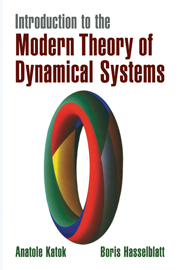Book contents
- Frontmatter
- Contents
- PREFACE
- 0 INTRODUCTION
- Part 1 Examples and fundamental concepts
- Part 2 Local analysis and orbit growth
- Part 3 Low-dimensional phenomena
- 10 INTRODUCTION: WHAT IS LOW-DIMENSIONAL DYNAMICS?
- 11 HOMEOMORPHISMS OF THE CIRCLE
- 12 CIRCLE DIFFEOMORPHISMS
- 13 TWIST MAPS
- 14 FLOWS ON SURFACES AND RELATED DYNAMICAL SYSTEMS
- 15 CONTINUOUS MAPS OF THE INTERVAL
- 16 SMOOTH MAPS OF THE INTERVAL
- Part 4 Hyperbolic dynamical systems
- Appendix: BACKGROUND MATERIAL
- NOTES
- HINTS AND ANSWERS TO THE EXERCISES
- REFERENCES
- INDEX
10 - INTRODUCTION: WHAT IS LOW-DIMENSIONAL DYNAMICS?
Published online by Cambridge University Press: 05 June 2012
- Frontmatter
- Contents
- PREFACE
- 0 INTRODUCTION
- Part 1 Examples and fundamental concepts
- Part 2 Local analysis and orbit growth
- Part 3 Low-dimensional phenomena
- 10 INTRODUCTION: WHAT IS LOW-DIMENSIONAL DYNAMICS?
- 11 HOMEOMORPHISMS OF THE CIRCLE
- 12 CIRCLE DIFFEOMORPHISMS
- 13 TWIST MAPS
- 14 FLOWS ON SURFACES AND RELATED DYNAMICAL SYSTEMS
- 15 CONTINUOUS MAPS OF THE INTERVAL
- 16 SMOOTH MAPS OF THE INTERVAL
- Part 4 Hyperbolic dynamical systems
- Appendix: BACKGROUND MATERIAL
- NOTES
- HINTS AND ANSWERS TO THE EXERCISES
- REFERENCES
- INDEX
Summary
a. Motivation. In Chapters 2, 3, and 4 we described two main thrusts in the theory of dynamical systems. The first one aims at the classification of various classes of systems up to smooth conjugacy, topological conjugacy, semiconjugacy with good properties, and, in the case of flows, orbit equivalence. The main tools for that approach are finding models and describing moduli. The second thrust is to describe (or calculate) the principal asymptotic invariants for various classes of systems as well as for concrete examples. These invariants include growth of periodic orbits, topological entropy, homo-topical and homological properties, recurrence properties, and statistical properties reflected in various properties of invariant measures.
For general dynamical systems only partial results in both directions can be obtained. In a very general sense the unifying theme of Part 2 was the identification and exploration of elements in the orbit structure that provide information in both directions, primarily the second one. More specifically we found out that such paradigms as hyperbolicity (Chapter 6), transversality (Chapter 7), the global topological structure (Chapter 8), and variational character (Chapter 9) ensure under certain conditions the presence of sufficiently rich and “interesting” asymptotic behavior.
However, there are two major areas where the program outlined and illustrated in Chapters 2, 3, and 4 can be advanced considerably further. Those are dynamical systems with low-dimensional phase spaces studied in the present part of the book and dynamical systems with hyperbolic structure which we began to discuss in Chapter 6 and will study in depth in Part 4.
- Type
- Chapter
- Information
- Introduction to the Modern Theory of Dynamical Systems , pp. 381 - 386Publisher: Cambridge University PressPrint publication year: 1995



